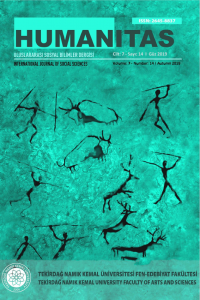The Bildungsroman as Monomythic Fictional Discourse: Identity Formation and Assertion in Great Expectations
Öz
In English literature, the Bildungsroman – vouched by a number of
predecessors and based on a long developmental process from antiquity through
romanticism to establish itself as a fictional subgenre with Goethe in Germany
– flourished as a self-contained literary system due to the aesthetic efforts
of various Victorians writers facing the co-existence of tradition, as realism
and, to a certain extent, post-romanticism, and of innovation, as symbolism,
aestheticism, and other forms of avant-garde. The novel of identity formation
became popular in particular among the realists, and significantly, a great
number of realist novels are Bildungsromane dealing with the development and
becoming of a protagonist. The aim of the present study is to show what makes the protagonist of a
Bildungsroman to be at the same time the hero of the monomyth. In order to
achieve this purpose, after having defined and shown the essence of the
Bildungsroman and the monomyth, we disclose the fictional pattern of the novel
of formation with its thematic and structural elements interrelated to form a literary
system, as well as the three-dimensional structure of the monomyth encompassing
the aspects of separation – initiation – return. Finally, in matters of exemplification
and practical argumentation, and relying on a comparative approach, we would
reveal similarities and
differences between the Bildungsroman and monomyth through textual reference to
a particular novel, namely Great
Expectations by Charles Dickens.
Anahtar Kelimeler
Bildungsroman monomyth identity literary system novel Victorian Age realism Charles Dickens
Kaynakça
- Campbell, J. (1968). The Hero with a Thousand Faces. Princeton: Princeton University Press.
- Dickens, C. (2008). Great Expectations. Oxford: Oxford University Press.
- Golban, T. (2014). Rewriting the Hero and the Quest: Myth and Monomyth in Captain Corelli’s Mandolin by Louis de Bernières. Frankfurt am Main: Peter Lang GmbH.
- Henderson, J. (1964). Ancient Myths and Modern Man. Man and His Symbols. Ed. Carl Jung. Garden City: Doubleday.
- Lowry, S. P. (1982). Familiar Mysteries: The Truth in Myth. Oxford: Oxford University Press.
- Moretti, F. (2000). The Way of the World: The Bildungsroman in European Culture. London: Verso.
- Noel, Daniel C. (1991). Revisioning the Hero. Mirrors of the Self: Archetypal Images that Shape Your Life. Ed. Christine Downing. Los Angeles: Jeremy P. Tarcher.
- Pearson, C. S. (1991). Awakening the Heroes Within: Twelve Archetypes to Help Us Find Ourselves and Transform Our World. New York: Harper Collins Publishers.
Öz
İngiliz edebiyatında oluşum romanı - çok sayıda öncül tarafından teyit edilen ve antik dönemden romantizme kadar uzun bir gelişim sürecine dayanan ve kendisini Almanya'da Goethe ile kurgusal bir alt tür olarak kurmaya çalışan - geleneğin, gerçekçilik ve bir dereceye kadar romantizm sonrası olarak, ve yenilikçiliğin sembolizm, estetikçilik ve diğer avangart biçimler olarak bir arada varoluşuyla karşı karşıya kalan çeşitli Victorya dönemi yazarlarının çabalarıyla kendine özgü bir edebi sistem olarak gelişti. Kimlik oluşumu romanı özellikle gerçekçiler arasında popüler oldu. Önemli ölçüde, çok sayıda gerçekçi roman, başkahramanın gelişimi ve kendini gerçekleştirmesiyle ilgilenen oluşum romanlarıdır. Bu çalışmanın amacı, bir oluşum romanının başkahramanını aynı zamanda monomitin kahramanı da yapanın ne olduğunu göstermektir. Bu amaçla, oluşum romanının ve monomitin özünü tanımladıktan ve gösterdikten sonra, oluşum romanının kurgusal modelini, edebi bir sistemin oluşması için birbiriyle ilişkili tematik ve yapısal unsurları ile açıklıyoruz. Bunun yanında monomitin ayrılma - kabul edilme - geri dönüşü kapsayan üç boyutlu yapısı ele alınacaktır. .Son olarak, örnekleme ve pratik argümantasyon konularında ve karşılaştırmalı bir yaklaşıma dayanarak, oluşum romanı ve monomit arasındaki benzerlik ve farklılıkları, Charles Dickens'in Büyük Umutlar romanına metin referansı yoluyla ortaya koyacağız.
Anahtar Kelimeler
oluşum romanı monomit kimlik edebi sistem roman Viktorya Dönemi gerçekçilik Charles Dickens
Kaynakça
- Campbell, J. (1968). The Hero with a Thousand Faces. Princeton: Princeton University Press.
- Dickens, C. (2008). Great Expectations. Oxford: Oxford University Press.
- Golban, T. (2014). Rewriting the Hero and the Quest: Myth and Monomyth in Captain Corelli’s Mandolin by Louis de Bernières. Frankfurt am Main: Peter Lang GmbH.
- Henderson, J. (1964). Ancient Myths and Modern Man. Man and His Symbols. Ed. Carl Jung. Garden City: Doubleday.
- Lowry, S. P. (1982). Familiar Mysteries: The Truth in Myth. Oxford: Oxford University Press.
- Moretti, F. (2000). The Way of the World: The Bildungsroman in European Culture. London: Verso.
- Noel, Daniel C. (1991). Revisioning the Hero. Mirrors of the Self: Archetypal Images that Shape Your Life. Ed. Christine Downing. Los Angeles: Jeremy P. Tarcher.
- Pearson, C. S. (1991). Awakening the Heroes Within: Twelve Archetypes to Help Us Find Ourselves and Transform Our World. New York: Harper Collins Publishers.
Ayrıntılar
| Birincil Dil | İngilizce |
|---|---|
| Bölüm | Tüm Sayı |
| Yazarlar | |
| Yayımlanma Tarihi | 15 Ekim 2019 |
| Yayımlandığı Sayı | Yıl 2019 Cilt: 7 Sayı: 14 |
Cited By
Bildungsromanlarda Kahramanın Sonsuz Yolculuğu
Söylem Filoloji Dergisi
https://doi.org/10.29110/soylemdergi.1301769








